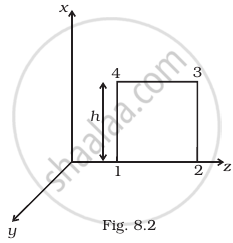Advertisements
Advertisements
Question
A charged particle oscillates about its mean equilibrium position with a frequency of 109 Hz. What is the frequency of the electromagnetic waves produced by the oscillator?
Solution
We know that an accelerated or vibrating charged particle produces a vibrating electric field. This electric field produces a vibrating magnetic field. Both these fields together produce electromagnetic waves whose frequency is equal to the frequency of oscillation of the vibrating particle.
Frequency of waves v = 109 Hz
APPEARS IN
RELATED QUESTIONS
How are em waves produced by oscillating charges?
How is the speed of em-waves in vacuum determined by the electric and magnetic field?
Explain briefly how electromagnetic waves are produced by an oscillating charge. How is the frequency of the em waves produced related to that of the oscillating charge?
Can an electromagnetic wave be deflected by an electric field or a magnetic field?
A wire carries an alternating current i = i0 sin ωt. Is there an electric field in the vicinity of the wire?
Which of the following electromagnetic radiations is used for viewing objects through fog ______.
Write down Maxwell equations in integral form.
A man standing on the road has to hold his umbrella at 30° with the vertical to keep the rain away. He throws away the umbrella and starts, running at 10 km/h and finds raindrops hitting his head vertically. The speed of the raindrops with respect to the road is ______.
Which of the following electromagnetic radiations has the smallest wave length?
Maxwell's equation describe the fundamental law of
Why is the orientation of the portable radio with respect to broadcasting station important?
Poynting vectors S is defined as a vector whose magnitude is equal to the wave intensity and whose direction is along the direction of wave propagation. Mathematically, it is given by `S = 1/mu_0 E xx B`. Show the nature of S vs t graph.
A plane EM wave travelling in vacuum along z direction is given by `E = E_0 sin(kz - ωt)hati` and `B = B_0 sin(kz - ωt)hatj`
- Evaluate `oint E.dl` over the rectangular loop 1234 shown in figure.
- Evaluate `int B.ds` over the surface bounded by loop 1234.
- Use equation `oint E.dl = (-dphi_B)/(dt)` to prove `E_0/B_0` = c.
- By using similar process and the equation `ointB.dl = mu_0I + ε_0 (dphi_E)/(dt)`, prove that c = `1/sqrt(mu_0ε_0)`

A plane EM wave travelling along z direction is described by `E = E_0 sin (kz - ωt)hati` and `B = B_0 sin (kz - ωt)hatj`. show that
- The average energy density of the wave is given by `u_(av) = 1/4 ε_0E_0^2 + 1/4 B_0^2/mu_0`.
- The time averaged intensity of the wave is given by `I_(av) = 1/2 cε_0 E_0^2`.
Which of the following statement is NOT true about the properties of electromagnetic waves?
A plane electromagnetic wave, has frequency of 2.0 × 1010 Hz and its energy density is 1.02 × 10-8 J/m3 in vacuum. The amplitude of the magnetic field of the wave is close to `(1/(4piepsilon_0) = 9xx10^9"Nm"^2/"C"^2 "and speed of light" = 3 xx 10^8 "m" "s"^-1)`:
A plane electromagnetic wave with frequency of 30 MHz travels in free space. At particular point in space and time, electric field is 6 V/m. The magnetic field at this point will be x × 10-8 T. The value of x is ______.
An electromagnetic wave is produced by a charge ______.
The diagram below shows the electric field (E) and magnetic field (B) components of an electromagnetic wave at a certain time and location.

The direction of the propagation of the electromagnetic wave is ______.
